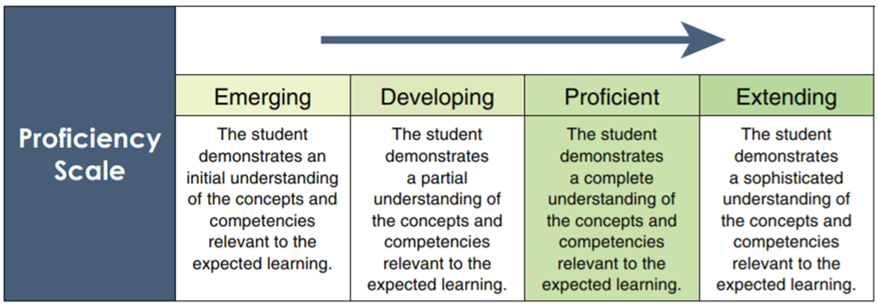VII. Competency-Based Assessment
Competency-Based Curriculum and Assessment
“British Columbia’s redesigned curriculum brings together two features that most educators agree are essential for 21st-century learning: a concept-based approach to learning and a focus on the development of competencies, to foster deeper, more transferable learning. These approaches complement each other because of their common focus on active engagement of students. Deeper learning is better achieved through “doing” than through passive listening or watching. Similarly, both concept-based learning and the development of competencies engage students in authentic tasks that connect learning to the real world.”
Source: Curriculum.gov.bc.ca/curriculum
Curriculum model: All areas of learning are based on a “Know-Do-Understand” model to support a concept-based competency-driven approach to learning.
Three elements, the Content (Know), Curricular Competencies (Do), and Big Ideas (Understand) all work together to support deeper learning.
Examples of the various types of assessments used in SD72:
| Assessment Type | Description | Link to Access |
SD72 Common Formative Numeracy Assessments (K-9) | The Common Formative Numeracy Assessment gages learners’ understanding of critical numeracy content and competencies. The CFNA package includes a variety of instructional / fluency-building resources for use throughout the year as well as recommended instructional routines related to the key competencies for each grade level. The CFNA will be administered near the beginning of the school year to activate and gage prior learning and set the focus for ongoing planning and support. | Section VIII: Common Formative Assessment |
Ongoing Formative Assessments (ie. SNAP) | The SD72 SNAP is fully aligned with the BC Curricular Competencies in math. Competency-based rubrics have been created for use in SD72 (grades 2 – 9). | See interactive PowerPoint keystone below |
| Formative Assessments from Carole Fullerton | Teachers in SD72 have access to a series of number-sense assessment tasks created by Carole Fullerton. The printable resources include assessment tasks for K-9. | Carole Fullerton Assessment Tasks |
| First Step in Math (FSiM) | Assessment Tasks for Number, Operations, Geometry, Measurement, and Data. The First Steps in Math program includes assessment tasks for grades K-8. A guide with suggested activities from the FSiM Number tasks, aligned to the BC Math curriculum is available using the link below: First Steps in Mathematics_Suggestions.docx | FSiM All Files |
Assessing Proficiency

Students are assessed using the Proficiency Scale
Student Numeracy Assessment and Practice (SNAP)
- The SD72 SNAP is fully aligned with the BC Curricular Competencies in math. Competency-based rubrics have been created for use in SD72 (grades 2 – 9).
- Designed as a whole class assessment, the Student Numeracy Assessment and Practice (SNAP) was developed by a group of educators from Chilliwack School District (SD33).
- The SNAP has been used in grades K – 7 classes since September 2016, informed by The ANIE Assessment-2014.
- The SNAP is designed to serve as a formative assessment and as an instructional routine throughout the entire year. It can be used to inform and guide instructional planning. SNAP is a two-part assessment that focuses on the foundational skills of mathematics: Number Sense and Operations.
SNAP Assessment and Practice Keystone
The interactive presentation below includes links to SNAP templates for grades K through 9, rubrics for number sense and operational fluency, and additional resources.
| Resource Description | Resource Link | |
| 1 | Criteria for designing and selecting numeracy assessments | Assessment Selection Design Criteria |
| 2 | Examples of Formative Assessment Practices | Gathering Evidence of Student Achievement.pptx |
| 3 | Self-reflection / student-assessment template | Numeracy Assessment Child Centered Standards |
| 4 | Reflecting on core competencies in math | Student Reflection (8 characteristics of an effective learner) |
| 5 | What does mathematical thinking look like? | Mathematical Habits of Mind |
| 6 | Poster (based on model from Geoff Krall) | How to BE a math person |
| 7 | Multi-grade trajectories (Proficiency Tables for K-9) | Foundational Numeracy, Operational Fluency, Algebraic Reasoning Trajectories |
| 8 | Circular Quick Scales Math K-9 | Numeracy Quick Scales BC |
| 9 | Grade Level Proficiency Descriptors (K-12) | Proficiency Descriptions Numeracy Learning Progressions |
| 10 | Sample Rubric-Style Progress Report with Evidence of Learning Column | Sample Math 9 Competency Summary Report 2024 |
| 11 | Student qualities and attributes (for progress reports & comments) | Communicating Learning Habits Engagement |
| 12 | Self-Assessment / Self-Check Tool | Writing and Math Self Check Pencil.pptx |




